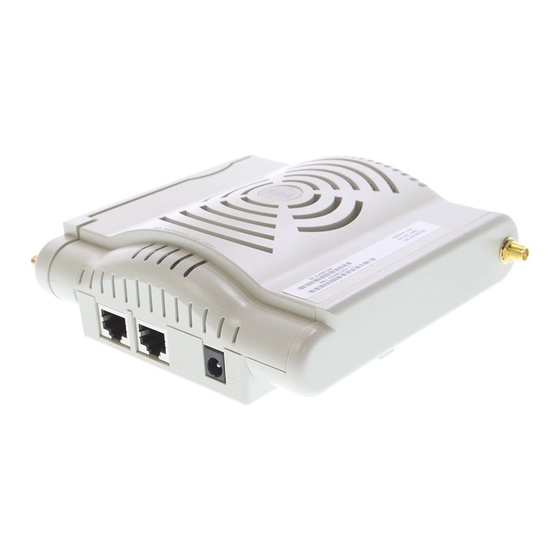
Table of Contents
Advertisement
Aruba AP-120 Series Indoor Access Point
Installation Guide
About the Aruba AP-120 Series Access Points
The Aruba AP-120 series of wireless access points support the imminent IEEE 802.11n (currently draft
2.0) standard for high-performance WLAN. These access points use MIMO (Multiple-in, Multiple-out)
technology and other high-throughput mode techniques to deliver high-performance, pre-802.11n
2.4 GHz and 5 GHz functionality while simultaneously supporting existing 802.11a/b/g wireless services.
The AP-120 series access points are available in versions with single or dual radios and with integrated
antennas or RP-SMA interfaces that support detachable antennas. The AP-120 series access points work
only in conjunction with an Aruba Mobility Controller.
The Aruba AP-120 series access points provide the following capabilities:
Wireless transceiver
Protocol-independent networking functionality
IEEE 802.11a/b/g or 802.11n operation as a wireless access point
IEEE 802.11a/b/g or 802.11n operation as a wireless air monitor
Compatibility with IEEE 802.3af PoE as well as high power over Ethernet pre-standards
(PoE + / 802.3at)
Central management configuration and upgrades through an Aruba Mobility Controller
Upgrade of AP-12x a/b/g models to 802.11n (draft) compliance through a controller license
!
CAUTION
N O T E
Figure 1 AP-120 Series Access Points
(3 x RP-SMA interfaces for detachable antennas)
0510457-06
| June 2008
The AP-12x a/b/g APs require ArubaOS 3.3.1.9 (or later). If you are running an earlier version of
ArubaOS, upgrade before installing the APs.
When installing the license to upgrade your AP-12x a/b/g AP to 802.11n compliance, you must
reboot the AP for the upgrade to take effect.
AP-120/124
ap12_001
AP-121/125
(3 x integrated dual-band antennas)
1
Advertisement
Table of Contents

Summary of Contents for Aruba AP-120 Series
- Page 1 2.4 GHz and 5 GHz functionality while simultaneously supporting existing 802.11a/b/g wireless services. The AP-120 series access points are available in versions with single or dual radios and with integrated antennas or RP-SMA interfaces that support detachable antennas. The AP-120 series access points work only in conjunction with an Aruba Mobility Controller.
-
Page 2: Package Contents
Use these materials to repack and return the unit to N O T E the supplier if needed. Additional mounting kits for use with the AP-120 series access points are sold separately. Contact your Aruba sales representative for details. N O T E... -
Page 3: Summary Of The Setup Process
AP-120 series AP. N O T E Successful setup of an AP-120 series access point consists of five tasks, which must be performed in this order: 1. Verify pre-installation connectivity. 2. Identify the specific installation location for each AP. -
Page 4: Unidentified Known Rf Absorbers/Reflectors/Interference Sources
You can mount the AP-120 series access point on a wall or on the ceiling. Use the AP placement map generated by Aruba’s RF Plan software application to determine the proper installation location(s). Each location should be as close as possible to the center of the intended coverage area and should be free from obstructions or obvious sources of interference. - Page 5 2. Align the mounting slots on the rear of the AP over the screws and slide the unit into place (see Figure Figure 2 Installing the AP-120 series Access Point on a Wall 3. On the AP-121 or AP-125, orient the antennas. For best performance, swivel the antennas so that...
-
Page 6: Using The Integrated Ceiling Tile Rail Slots
Figure 6 Antenna Orientation on a Ceiling-Mounted AP-121/AP-125 On the AP-120 or AP-124, install the external antennas according to the manufacturer’s instructions, and connect the antennas to the antenna interfaces on the AP (see Figure Aruba AP-120 Series Indoor Access Point | Installation Guide... -
Page 7: Connecting Required Cables
Use these ports to connect the AP to a twisted pair Ethernet LAN segment or directly to an Aruba Mobility Controller. Use a 4- or 8-conductor, Category 5 UTP cable up to 100 m (325 feet) long. Aruba 12x APs are intended only for installation in Environment A as defined in IEEE 802.3.af, Power over Ethernet. -
Page 8: Power Connection
Output Output Power Connection The AP-120 series AP has a single 5V DC power jack socket to support powering through an AC-to-DC mains electric power adapter. Connecting a Security Cable To provide added security for the AP-121 or AP-125, you can attach a security cable to the back of the... -
Page 9: Product Specifications
Provisioning parameters are unique to each AP. These local AP parameters are initially configured on the Mobility Controller which are then pushed out to the AP and stored on the AP itself. Aruba recommends that provisioning settings be configured via the ArubaOS Web UI only. Refer to the ArubaOS User Guide for complete details. -
Page 10: Wireless Lan
5 VDC power interface, supports powering through an AC-to-DC mains electric power adapter If a power adapter other than the one provided by Aruba Networks is used in the US or Canada, it should be cULus (NRTL) Listed, with an output rated 5 VDC, minimum 4A, marked “LPS”... -
Page 11: Safety And Regulatory Compliance
802.11n - Data rate MCS0 – MCS15 (from 6.5 Mbps to 300 Mbps) Safety and Regulatory Compliance Aruba Networks provides a multi-language document that contains country-specific restrictions and additional safety and regulatory information for all Aruba access points. This document can be viewed or downloaded from the following location: www.arubanetworks.com/safety_addendum RF Radiation Exposure Statement: This equipment complies with FCC RF radiation exposure limits. -
Page 12: China Rohs
Batteries included with Aruba Networks products must be replaced by qualified Aruba Networks service personnel only. Contact Aruba Networks for battery replacement. Do not attempt to replace the battery. There is a risk of explosion if you install the wrong type of battery. Dispose of batteries CAUTION according to the instructions.













Need help?
Do you have a question about the AP-120 Series and is the answer not in the manual?
Questions and answers